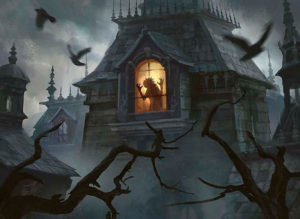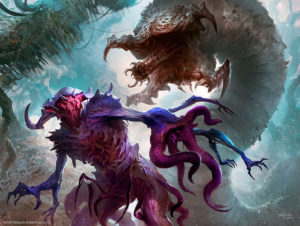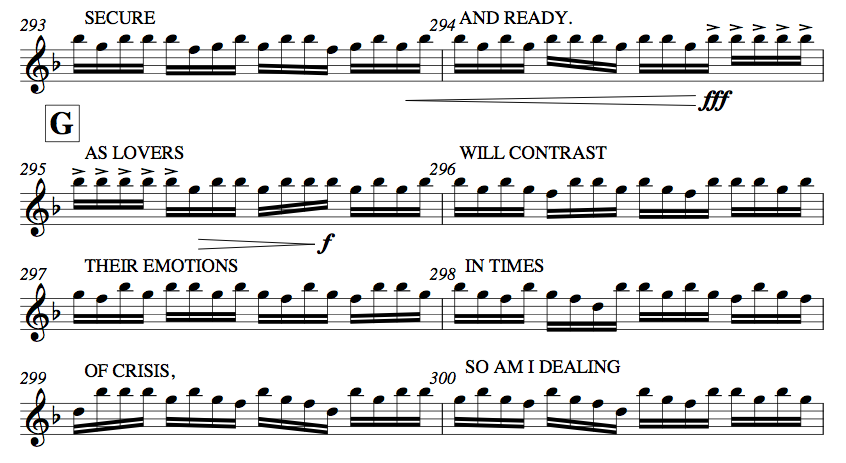Evolving Wilds is a high pick in Battle for Zendikar draft, but that wasn’t always the case. The limited metagame has shifted from the early days of the format, and colorless mana-fixers have shot up in value. Why?
Battle for Zendikar has proven to be a tricky and unusual draft format. Who would have thought jamming Eldrazi and landfall creatures in the same set would be weird? The set spoiler presented itself as a collection of two-color archetypes based around unique mechanical synergies. Find the open color pair and know how to build that deck. But as the format has evolved, the pros have started to reevaluate what works. Luis Scott-Vargas recently began a series of limited re-reviews. Jon Finkel wrote a report of his top four finish at the Pro Tour, and questioned the perceived supremacy of synergy decks in draft. Ari Lax wrote a perceptive reevaluation of how the limited format works.
The draft environment has one big problem—green is clearly the weakest color. Any format with an obvious worst color suffers. Remember Avacyn Restored? Black was woefully underpowered. Magic 2014? You really did not want to play white. And in Battle for Zendikar, people avoid green like the plague. There have been splashes of brilliance, some strong multicolor converge decks, a few good Ally builds, but mostly drafting green is a death sentence. As Ari Lax aptly put it, who wants to “[t]ry to navigate your way through a very difficult set of decisions on very little practice and get super punished if you mess up[?]”
If everyone avoids green, then too many players fight for the other colors. Only six of ten two-color archetypes lack green, meaning the card pool can’t support seven or eight drafters—the no-green metagame. Normally this is self-correcting, because the undrafted color will circle the table in such density that someone would take all the green cards and have an amazing deck. But in Battle for Zendikar, the green cards don’t assemble into a coherent deck. You could have the 20 best green cards in the draft, and they might not work together. Snapping Gnarlid, Eyeless Watcher, Tajuru Stalwart, and Unnatural Aggression don’t combine particularly well, even if you can buy them all back with Greenwarden of Murasa. Going all in on green fails to pay off.
Once everyone is fighting for six archetypes across four colors, decks run thin on playables. That means you need to splash some power from a third color. When you take that route, synergies break down and raw power reigns supreme. This is how a synergy format turns into a power level format, and how Evolving Wilds becomes a high pick. Finkel, a true limited genius, saw it early, even if he didn’t extrapolate out to the ubiquity of splashing.
But this format does not overflow with powerful cards. If everyone drafts jund-style good stuff decks, power gets diluted and many decks flounder in the mediocre midrange. Skillful play becomes the deciding factor in what decks win, but the metagame can shift back as players find open two-color synergy decks and crush the diluted good stuff decks. In Battle for Zendikar, this appears to create a cyclical equilibrium. Synergy and power level shift in importance from draft to draft. To navigate this, you have to read signals very carefully and understand exactly what you need build a successful deck of either style. Derek’s article last week navigating the first five picks of pack one provides a great primer.
Enter Broodhunter Wurm. The four mana green 4/3 has been much maligned and thrown in the close-to-unplayable pile. How can that possibly be true? Yes, a 4/3 is less impressive in Battle for Zendikar than, say, Khans of Tarkir. The best combinations of power and toughness fluctuate between sets. If you care about how your creatures match up against your opponent’s creatures in combat, then a 4/3 for four mana could be so mis-sized in a format that it plummets in value. But what if your deck doesn’t care about lining up favorable creature combat? What if you play a removal-heavy control deck with some card advantage and finishers? Then your creatures merely need to fill out your deck, provide some early resistance, and attack effectively when top-decked late in an attrition battle.
I’m not saying that Broodhunter Wurm is a great card. But it is secretly a synergy card for the anti-synergy deck. A text box full of flavor text doesn’t combine with other cards, but the lack of any ability guarantees that you only pay for power and toughness. If all you need to round out your control deck are a few creatures that rumble in combat, then a tenth pick Broodhunter Wurm is perfect. You don’t need bells and whistles, and the wurm is anti bell, anti whistle. You aren’t paying an extra mana for some ability you can’t use. Synergy decks jell when the bad cards nobody else wants come around on the wheel. That’s exactly what the vanilla 4/3 offers to a deck not looking for synergy cards.
You might not want to play green in your good-stuff deck, given green’s lack of good stuff. But Belligerent Whiptail fills the same role. Nobody wants that card, but it has four power for four mana. It isn’t going to win you the game, but you can work it into your plan despite it being one of the worst cards in your deck. Everyone wants to draft red cards, so you have to take what you can get to complement the powerful core you build around.
It all comes down to this: all draft decks are synergy decks. Limited forces you to extract the most value from every pick of the draft, every card in your pool, every mediocre version of a good card. Recognizing what holes you can fill with late picks pays big dividends. When you have fifteen amazing cards that provide incremental advantage over your opponent, you can round out your deck with playable chaff. Early in a pack, look at the mediocre role players that will likely wheel, and try to build your deck to have those cards fit into your holes.
And finally, be open to splashing. Don’t go out of your way, but if Evolving Wilds comes by early in a weak pack, take it and open the door to pick up any splashable card you want. Even off-color sideboard cards like Boiling Earth or Giant Mantis are worth taking to improve your pool. You never know what other cards of that color might come along. Being able to dip into a third color expands your options in every pack of the draft, and having a couple “support” cards of that color can justify devoting lands slots to casting the good ones.
Battle for Zendikar pushes players away from green, and the metagame has warped in response. You should expect to fight for the good colors, and you need to stay open to assemble the optimal pool for your seat. Take flexible and powerful cards early, look for the filler you can expect to get late, and find the other cards that come togther to form your deck.
I’ll see you at Grand Prix Atlanta this weekend. Good luck!
Carrie O’Hara is Editor-in-Chief of Hipsters of the Coast.




